Acne all over the body, the causes of which can be very diverse, causes a lot of trouble not only for teenagers, but also for adults. In this case, the affected area can be not only the face, but also the torso, and even the feet. Usually they accumulate in a certain place, which indicates certain diseases of the internal organs. If you notice clusters of rashes on your body, go to the hospital immediately. Only a correct diagnosis can guarantee successful treatment. Usually the doctor prescribes certain medications and recommends undergoing a set of cosmetic procedures.
Acne all over the body: causes
There are many reasons why rashes appear on the body. Let's look at the most popular and common:
- Heredity. Very often, parents with acne pass this deficiency on to their offspring.
- Problems with hormones. Very often, a hormonal imbalance leads to the formation of acne not only in teenagers, but also in adults. If we talk about young people, then acne is just a signal from the body that it is being rebuilt and sex hormones are produced in very large quantities. Juvenile acne goes away immediately after hormonal levels are restored. But if gynecological or endocrine diseases are observed, then the rash will be present until you get rid of your problems.
- Diseases of internal organs. Very often, acne on the body is evidence that your digestive system is not working properly. However, there are cases of damage to other internal organs.
- Oily skin. If you have this type of skin, then a very large number of pathogenic microorganisms multiply on your epidermis. To eliminate them, you cannot do without regular hygiene and cosmetic procedures.
- Poor nutrition. Try to reduce your consumption of fatty, fried and spicy foods. And you yourself will notice how the number of rashes on your body will significantly decrease.
- Pimples all over the body, the causes of which may be hidden under reduced immunity, very often worry not only teenagers, but also mature adults. If your body is weakened, bacteria will develop not only inside the body, but also on its surface.
- Using bad and inappropriate cosmetics. Use only those creams and other care products that are ideal for your skin type. This is especially true for oily skin. Look at the composition of the product, as well as its expiration date.
- Medicines. The use of many medications can cause pimples to appear on all parts of the body. Antibiotics have a particularly bad effect.
- Stress and nervous tension are very common causes of rashes. It is stress that reduces the level of immunity and causes harmful bacteria to accumulate on the surface of the skin.
- Demodex mite. If your sebaceous glands are disrupted, then most likely a parasite such as demodex has settled on your body. It is he who provokes a large number of inflammations on the skin.
Rash on the back and chest
Pimples all over the body, the causes of which depend on pathologies and diseases, worry many people. What to do in cases where rashes appear on the chest and back? In fact, this problem is quite easy to get rid of.
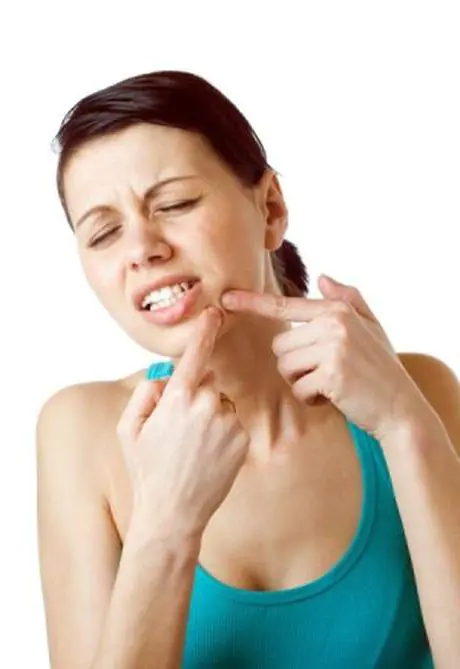
Pay attention to the clothes you wear. Synthetic fabric does not allow moisture to pass through and does not allow the skin to breathe. When wearing such things for a long period of time, bacteria multiply on the body, which causes rashes.
You may be allergic to materials and dyes. In any case, try to wear natural fabrics. Find out which factories sew products using natural dyes.
If you wear clothes that are very tight to your body, then this can also cause acne to appear on your body. Reasons for this: irritation and excessive sweating.
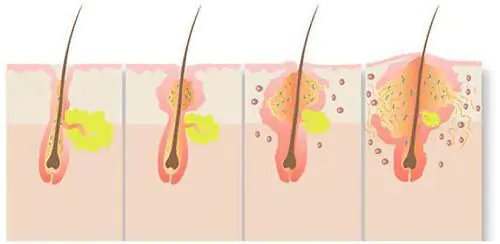
Excessive exposure to sunlight. Ultraviolet radiation has a detrimental effect on the delicate skin in the chest area. This is what causes the rash.
Another reason is long hair. They completely cover the back and do not allow it to breathe.
Rash on hands
Due to an unbalanced diet, as well as an unhealthy lifestyle, acne may appear on the hands. Most often, this phenomenon occurs as a result of a deficiency of a vitamin or mineral. However, it is impossible to determine for yourself what exactly is missing. Be sure to go to the hospital and undergo a thorough diagnosis.
Rash on the stomach
Pimples on the body (causes, treatment should only be determined by the attending physician) are most often the result of a certain disease. Pay special attention to rashes on the abdomen. In this case, acne can appear not only in an adult, but also in a child.
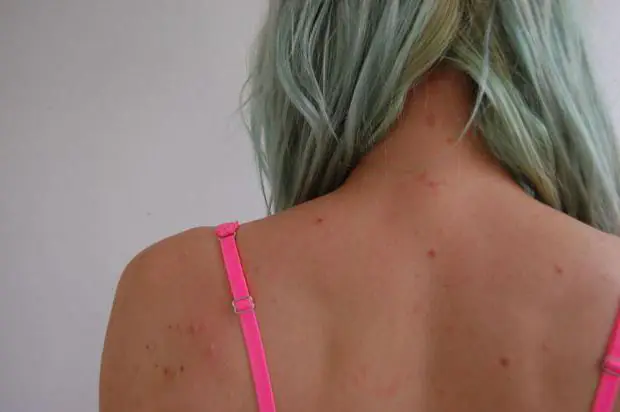
Heat rash is a fairly common occurrence. Very common in babies due to prolonged wearing of diapers. It also occurs due to high temperatures and high humidity.
Measles is a dangerous disease that is contagious. It is characterized by a rash that appears all over the body, as well as a high fever.
Chickenpox is a disease most often found in children. But it can also appear in adults. Characterized by pimples with light contents. To eliminate them, you need to use antiseptic drugs.
Rash on legs
The reasons for the appearance of acne on the body can be very diverse. In any case, they cannot be ignored. After all, they are the result of some disease or problem. Very often, a rash on the legs can appear after shaving, as well as from exposure to cold.

Overweight people may develop acne between their thighs. This happens as a result of the legs rubbing against each other. In this case, you need to choose the right clothes and adjust your diet.
If you notice a rash on your feet, immediately go to a dermatologist. Such a syndrome will not lead to anything good. In any case, take care of your hygiene and choose the right shoes, clothes and cosmetics.
Diseases of the feet
Acne on the body (reasons, photos can be seen in this article) can be the result of serious disorders in the body. This is especially true for the feet, because they lack sebaceous glands. Such symptoms will signal dangerous diseases such as eczema, dyshidrosis and itchy dermatitis. Pimples and blisters may form on the skin and, when opened, release a clear liquid.
Purulent acne on the body: causes
Most often, purulent acne appears on the body, back, shoulders and chest. However, such formations can also form on other areas of the skin. Very often they are a consequence of increased activity of the sebaceous glands. Another cause is hyperkeratosis. That is, the dermis thickens and the sebaceous glands become overcrowded. And this leads to the formation of acne.

Another reason is the use of antibiotics, especially in cases of long-term use and large dosages. You need to be especially careful when taking steroids.
Acne can appear during hormonal changes in the body, as well as during menstruation.
Pay attention to the cosmetics you use. Preparations with a large number of chemicals lead to the formation of purulent acne. The same applies to low-quality decorative cosmetics.
How to get rid of purulent acne
Of course, you need to visit a dermatologist who can conduct the necessary examinations and prescribe further treatment.

You should not squeeze out the pus, as you may cause an infection. Use iodine. Just apply it directly to the area of inflammation. Do this procedure every day until the inflammation completely disappears. In this case, you will protect yourself from the formation of scars. Aloe juice and medicinal ointments help well.
Medications
Purulent acne on the body, the causes and treatment of which can be very different, requires special attention. In addition to eliminating the cause itself, you need to take care of the foci of inflammation. Wipe your face with herbal infusions. You can use calendula or chamomile. Dermatologists recommend using “Zinerit”, “Levomekol” and “Skinoren”. Each of these drugs will do a great job with purulent acne and make your skin clean and beautiful.

Don't forget to take care of your hygiene and proper nutrition. Such simple rules can save you from many problems. Start doing this right now, and no skin problems will bother you anymore.
Acne periodically occurs in adults and adolescents; this problem is especially common in oily and combination skin types. The reasons for the appearance may be different - non-compliance with hygiene rules, the presence of serious pathologies. What medications will help get rid of acne?
When acne occurs, adults rarely seek help from a doctor or cosmetologist; they prefer to simply cover the pimple with an expensive product. But getting rid of rashes is guaranteed only after identifying the cause of the appearance. Often, rashes are formed when the sebaceous glands are overactive - the pores become clogged with sebum, and comedones appear.
Why do acne appear?
What can cause acne:
- Hormonal imbalances. Proper metabolism depends on hormones; if more of them are produced than necessary, problems with the dermis begin. Most often, acne on the face appears during puberty, during pregnancy and before menstruation in adult women.
- Rashes due to diseases of the digestive system. The skin reflects the general condition of the body; any disruptions manifest themselves in the form of acne on the face or body. Problems with the liver, gall bladder, and intestines provoke the occurrence of acne. Most often appear in people after 30 years of age.
- Unbalanced diet. Many foods cause acne. Rashes occur with excessive consumption of fatty, spicy, smoked foods. Such food provokes a hormonal surge, which causes various types of rashes.
- Failure to comply with hygiene rules. During the day, adults and children often touch their faces with dirty hands, many pathogenic microorganisms get on the skin - this is the main reason for the appearance of acne on the face.
- The habit of squeezing out acne on your own, which leads to infection, is a common cause of acne in men. This procedure should be carried out only in beauty salons, where a specialist can provide the necessary sanitary conditions.
- Demodex mite - penetrates the skin, provokes the appearance of purulent pimples and acne in adults and children. If you suspect the presence of a parasite, you should visit a dermatologist.
- Stress, overwork, lack of sleep, and working in a stuffy room with dry air can cause acne.
Acne in women that occurs periodically should not cause much concern. But if there are many rashes, they appear frequently, and are purulent in nature, it is necessary to undergo a full examination, reconsider your diet, and lifestyle.
Why does acne appear on different parts of the face?
Pimples on the face are often the first sign of serious illness in adults; depending on their location, you can understand which system has failed.
1. Acne on the chin appears when there are disturbances in the functioning of the digestive and endocrine systems. In women, such rashes indicate ovarian diseases and hormonal imbalance. If acne appears frequently in this area, it is necessary to consult a gynecologist, endocrinologist, and undergo a full examination. Acne on the lower part of the face also occurs when there are problems with the digestive tract, due to the high content of toxins in the blood, which are partially released through the pores on the face.
Pimples often appear on the chin and lower cheekbones in winter and autumn. Such rashes are of a cold nature and are often the first sign of influenza or acute respiratory infections. Acne in this part of the face can be caused by the habit of resting your head on your hands - germs and bacteria get on the skin.
2. Pimples on the forehead occur very often - in this area there are many sweat and sebaceous glands, the pores become clogged with dirt and grease. Rashes in this part indicate problems with the pancreas, gall bladder, and intestines. If comedones are located close to the brow ridges, then the cause is dysbacteriosis. If there is an accumulation of foci of inflammation closer to the hairline, you should check the gallbladder; stones may have formed.
Pimples on the forehead appear against the background of severe intoxication, accumulation of toxins and wastes in the body, with an unbalanced diet, addiction to junk food and drinks. Rashes may appear after long-term use of certain medications or antibiotic therapy.
3. What can cause acne around the mouth and lips? The main reason is serious disturbances in the functioning of the intestines and esophagus. Often such rashes are accompanied by constipation or diarrhea, colic. Eating foods high in fiber, seasonal vegetables and fruits will help eliminate the problem; if you have acne in this part of the face, you should avoid stress and mental strain.
4. What causes pimples on the nose? Enlarged pores often occur in the T-zone; it is in this area that the skin has increased oil content. The cause of rashes is hormonal fluctuations, which are often observed in adolescents and pregnant women. Acne around the nose can be a consequence of a malfunction in the organs of the endocrine, immune, digestive, and cardiovascular systems.
5. The main reason for the appearance of acne in the bridge of the nose is a large load on the liver, the organ does not cleanse the blood well, and some of the harmful substances come out through the skin. Excessive protein diets can trigger a rash.
6. Why do acne appear on the face in the cheekbones and cheeks? The reasons are different - hormonal imbalances, hereditary factors, intestinal diseases, inflammation in the ovaries and other gynecological pathologies. Acne on the cheeks often occurs with weak immunity, disruption of metabolic processes in the body, and the use of poor quality cosmetics.
Drug treatment
To effectively eliminate subcutaneous acne and other rashes on the face in men and women, you need to know not only the causes, but also methods for eliminating them. If acne occurs frequently, cosmetic and folk remedies do not always help; treatment with medications is necessary. The basis of therapy is antibacterial drugs in the form of tablets and ointments, which are selected by the doctor.
What antibiotics are suitable for treating subcutaneous acne:
- Erythromycin - used externally as a drying agent, eliminates microbes.
- Levomycetin - must be used to eliminate bacteria resistant to other types of antibiotics.
- Levomekol (more about the treatment of acne with Levomekol), Zinerit - antibacterial ointments that prevent the spread of acne.
- Trichopolum accelerates the regeneration process and effectively fights purulent rashes.
- Tetracycline - helps fight acne, quickly eliminates almost all types of pathogenic microorganisms.
- Solutab – has a pronounced bacteriostatic effect.
While taking antibiotics, it is necessary to take immunomodulators, drugs that normalize intestinal microflora, and include various low-fat fermented milk products in the diet.
If subcutaneous acne occurs frequently in men and women, Roaccutane is prescribed, a potent drug from the group of retinoids. The medicine is effective, but has many side effects - allergies, inflammation, nervous disorders. The product normalizes the functioning of the sebaceous glands, reduces their size, but can cause severe dryness of the skin. Treatment is long-term, at least 4 months.
Hormonal drugs are prescribed to treat acne in women with high levels of testosterone in the blood. The safest contraceptives are Janine, Mediana. The drugs are used as additional therapy; their effect on dermatological inflammatory processes is minimal.
When treating acne on the face, it is necessary to completely exclude fatty and smoked foods from the diet; you should not squeeze out acne yourself, or heat or steam purulent rashes.
Diet and preventive measures
Timely prevention and proper nutrition are the key to clean and healthy skin. A special anti-acne diet will help prevent breakouts on the face and body and eliminate the main causes of pimples.
How to prevent subcutaneous acne:
- regularly visit a cosmetology salon, do deep facial cleansing;
- Avoid eating fried, fatty and sweet foods, carbonated drinks, strong tea, coffee;
- include seasonal vegetables and fruits in any form in the diet, with the exception of potatoes, grapes, bananas;
- undergo a preventive examination annually;
- use only high-quality cosmetics and skin care products;
- avoid stress, get enough sleep, spend more time in the fresh air;
- observe the drinking regime - drink at least 2.5 liters of clean water per day.
An anti-acne diet involves a healthy, balanced diet. It is allowed to eat lean meats and fish, drink natural juices and fruit drinks, and herbal teas. The diet must include first courses in weak meat broth, various cereals, hard cheese, dairy and fermented milk products. Oatmeal and rice porridge cope best with acne; garlic and ginger cleanse the skin well.
As food additives, you can use bran, brewer's yeast in capsules, and flaxseed. Fasting days are beneficial for the skin - they should be done once a week.
The causes of acne are quite different and may indicate the development of serious diseases. Self-medication is ineffective; only a dermatologist or cosmetologist can select adequate drug therapy. To prevent acne, you need to eat right, get plenty of rest, regularly care for your skin, and avoid touching your face with dirty hands.
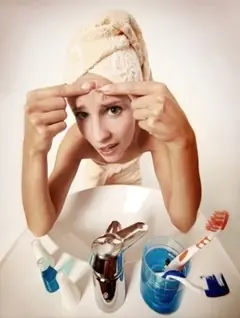
In the fight against acne, the initial task is to find out the causes of their occurrence.

If you suffer from acne, it is recommended to visit an endocrinologist and check your hormonal levels.

In some cases, acne may be the result of an allergic reaction.
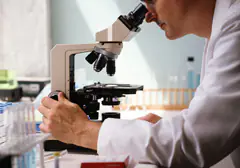
Demodicosis is a disease caused by the microscopic Demodex mite, which can cause progressive acne and pimples.
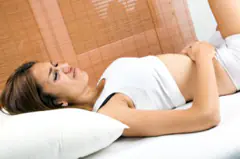
Acne often occurs in people suffering from intestinal dysbiosis.
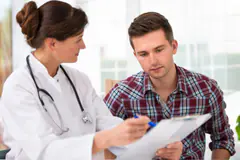
Weakened immunity sets the stage for various ailments that can cause, including acne.
Morning, you set the coffee to brew and rush to the bathroom for a morning shower. The day promises to be wonderful, long and full of meetings and discoveries. However, one look in the mirror and the good mood disappears... Acne, or acne, this scourge of youth, grows older every year. And now, even at 40 years old, no one is protected from it. However, let's understand the causes of acne and the means to combat acne.
City air, consumption of fast food and other factors significantly prolong the period of activity of the sebaceous glands and expose the skin to additional stress, which makes this disease a disease of all ages. However, undoubtedly, it is the teenage and post-adolescent periods of hormonal “bursts”, the beginning of which is signaled by the appearance of acne, that are distinguished by the most active manifestation of this skin disease of the face, and sometimes the body.
Causes of acne on the face, types of acne
So, the most common cause of acne on the face is hormonal changes in the body. Of course, adolescence is the most striking example of this. In a person’s life, this is the period of greatest hormonal activity. A hormonal storm rages inside the body, and outside we see its consequences - a roughening voice, changing body proportions and, alas, acne. Few people manage to avoid this scourge - teenage acne. Even if growing up proceeds within normal limits and the skin is quite thin and problem-free, it is impossible to go through puberty without a single pimple - they will appear, even if only in single quantities.
Similar work of the hormonal glands also occurs in women during pregnancy and a certain phase of the menstrual cycle (and this can also be accompanied in some cases by acne) or with certain endocrine problems in adults. Even newborn babies exhibit conditions similar to acne - they also have a hormonal nature, even a separate name - hormonal crisis. In addition, some medications, specifics of work, even inhaled air - all this can become a pathogenic factor for acne.
Actually, the word pimple is not exactly a medical term, or rather, its meaning is too vague. Experts distinguish the following types of acne:
- Comedo. This is not even a pimple, but a “pre-pimple” or a so-called white pimple. A comedon is a sebaceous plug that clogs a pore, causing future inflammation. In everyday life, comedones are also called “blackheads”; black color is the color of oxidized sebum on the surface of the comedones. If a plug has formed in the upper part of the pore, this is an open comedon; on the surface of the skin it appears as an easily removable tubercle filled with liquid. A closed comedon is, accordingly, localized deeper in the pore. On the skin it appears as a dense white ball, a wen. If such a comedone gets infected, a papule develops.
- Papule. This is already a full-fledged pimple, it is inflamed and painful on palpation, which is why its color can vary from red to bluish. When pressed, it turns pale, then becomes filled with blood again.
- Pustule. May be primary. Capable of emerging from a papule. It differs from the latter in the presence of purulent contents, which emerge on the surface of the pimple as a white dot. Papules and pustules have the common name “red pimples.”
- Nodular cystic acne. Severe form of pustules, which are no longer single, but form conglomerates penetrating deep into the dermis; they are connected by fistulous ducts and are quite painful. They require serious systemic treatment.
- Lightning acne. The most severe form of acne is accompanied not only by large areas of acne, but also by hyperthermia, muscle and bone pain, and changes in the leukocyte formula of the blood. Requires immediate medical attention.
Depending on the type of rash, there are four degrees of acne severity:
- First degree. A local area of the face is affected (for example, the forehead or chin). Rashes in the form of comedones, occasionally papules and pustules.
- Second degree. It differs from the first degree quantitatively - a large surface of the face is affected, there are rashes on the body. The qualitative composition of acne is the same as in the first level disease - comedones, single papules and pustules.
- Third degree. In addition to comedones, there are many papules and pustules, the inflammatory process is pronounced, and hyperemia (redness, itching) of the skin is possible. Post-acne marks.
- Fourth degree, the heaviest. Large spherical pimples (more than 5 mm), bluish-red in color, penetrate deep into the layers of the dermis and leave behind deep atrophic scars (they look like pits on the skin).
Table 1. Classification of acne (causes and types)
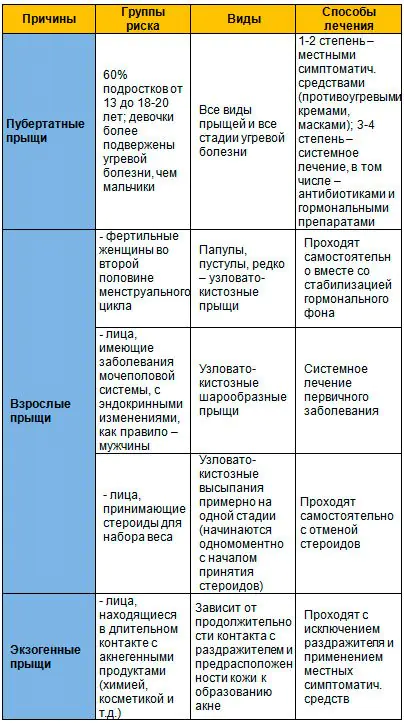
In addition to these factors, the severity of acne can also be determined by skin genetics. The production of sebum and the possibility of seborrhea (hyperactivity of the sebaceous glands) depends on the thickness of the skin of a particular patient.
Table 2. Intensity and area of acne spread for different skin types during puberty
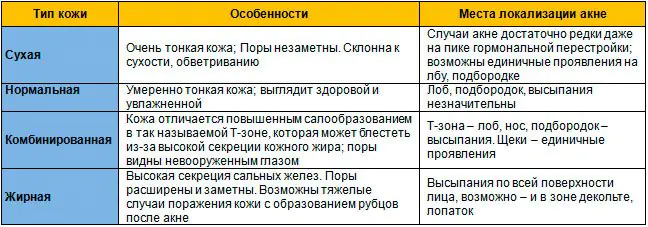
Remedies for acne and acne marks
When we talk about acne prevention, we, of course, mean the first two mild degrees of acne. Under no circumstances try to deal with serious boils, nodular cystic or fulminant acne on your own - this can be fraught not only with serious skin problems, but also with sepsis in especially severe cases.
However, if we are talking about mild acne lesions, treatment, which essentially boils down to the prevention of the disease, can be independent. Of course, this should be done correctly, because any irritation of the acne will indicate their growth. Cosmetologists categorically prohibit any unprofessional squeezing of pimples or comedones - this is fraught with the formation of new, more complex pimples, as well as the formation of atrophic scars, the fight against which is much more difficult than with mild degrees of acne, which go away without consequences for the skin. In general, experts recommend:
- review your diet during the period of highest activity of the sebaceous glands, that is, exclude fatty, sweet foods rich in simple carbohydrates;
- increase facial and hand hygiene measures. This will contribute, if not to the complete disappearance of acne, then at least to their non-proliferation due to external factors;
- regularly use antiseptic masks and creams that protect the pores from the penetration of dirt, dust particles and bacteria, which, in fact, trigger the inflammatory process.
Let's take a closer look at the last point. Humanity has been struggling with acne for more than a millennium, and during this time many folk and pharmacological drugs have been invented that cope with acne with greater or lesser success.
Table 3. Types of medications used for mild cases of acne
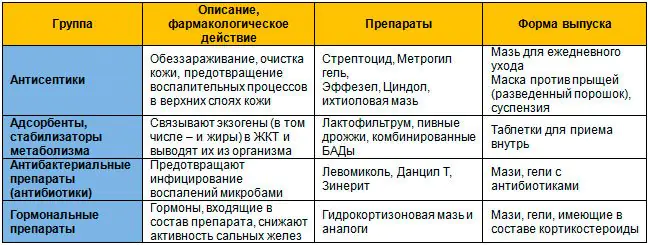
All these products should be used with caution, with mandatory testing on a small area of skin. Despite the fact that many ointments and gels are supported by vitamin complexes and special nutrition for the skin, during the treatment period much attention should be paid to daily facial care. Oily skin does not mean moisturized. Suspensions and creams can dry out the skin, peeling and itching can become an additional factor in its irritation and infection. Regular disinfection kills not only pathogenic, but also the skin’s own protective flora, also making it vulnerable. All this should be taken into account when starting treatment with acne creams and ointments. Antibacterial and hormonal drugs should be used with particular caution, treatment of which should definitely be carried out under the supervision of a doctor and involves undergoing numerous tests. It should also be remembered that acne leaves pigmentation on the skin, which, although it goes away over time, also requires additional attention. Cosmetology will also help speed up the depigmentation process - whitening clay masks, creams with high UV factors that protect against solar pigmentation. It is impossible to remove atrophic scars with pharmacological means - this problem can only be solved in beauty salons with laser resurfacing and other means of hardware cosmetology.
Determining the causes of acne on the face
Getting rid of acne will be truly effective only if it is under the supervision of a specialist. Even a mild form of the disease, if prolonged, indicates problems with hormonal levels or with the functioning of internal organs. Therefore, it is best to consult not only a cosmetologist, but also an endocrinologist, who will prescribe the necessary tests, select the right diet, and determine the optimal treatment strategy and tactics. Contrary to popular belief, this is a shorter and less expensive way than constantly thoughtlessly changing jars and tubes in the hope of “maybe”. Any treatment begins with laboratory and hardware diagnostics, which can be quickly and comfortably carried out in the INVITRO network of modern laboratories. They are located in almost all districts of Moscow.



